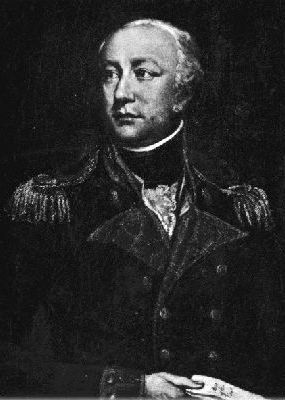William Mudge facts for kids
Quick facts for kids
William Mudge
|
|
|---|---|
 |
|
| Born | 1 December 1762 Plymouth, England
|
| Died | 17 April 1820 (aged 57) |
| Nationality | British |
| Occupation | Surveyor |
| Known for | Triangulation of Britain |
William Mudge (1762–1820) was an English army officer and surveyor. He was born in Plymouth, England. Mudge became a very important person in the Ordnance Survey, which is the national mapping agency of Great Britain.
Contents
Early Life and Career
William Mudge was born on December 1, 1762. His father was Dr. John Mudge. When William was young, a famous writer named Samuel Johnson visited him. Johnson was his godfather.
In 1777, William started studying at the Royal Military Academy, Woolwich. This was a special school for army officers. After graduating, he joined the Royal Artillery in 1779. He was sent to South Carolina to serve in the army. He became a first lieutenant in 1781.
When he returned to England, Mudge continued his studies. He learned advanced mathematics. He also enjoyed building clocks in his free time.
Leading the Ordnance Survey
In 1791, William Mudge joined the Ordnance Trigonometrical Survey. This group was responsible for making accurate maps of Britain. Mudge became the director of the survey in 1798. That same year, he was chosen to be a member of the Fellow of the Royal Society, a very respected group of scientists.
Mapping Great Britain
Around 1800, Mudge and his team started a big project. They used a method called triangulation to map Great Britain. Triangulation helps measure large areas by creating triangles. They used Dunnose as a starting point.
From 1801 to 1802, they measured a long line going north into Yorkshire. They found the exact locations of 23 points. They also measured the distances and directions between these points. This work was very important for creating detailed maps.
Some people later questioned how accurate these measurements were. But Mudge's work was still a huge step forward in mapping.
Life as a Surveyor
William Mudge continued to rise in the army. He became a major in 1801 and a lieutenant-colonel in 1804. He lived in London while leading the survey.
In 1809, he also became the lieutenant-governor of the Royal Military Academy at Woolwich. He made sure that students learned about surveying and drawing maps. He wanted them to be well-prepared for their careers.
Extending the Survey to Scotland
In 1813, the survey team decided to extend their mapping into Scotland. Mudge was in charge of this large project. He even helped with some of the actual measurements himself.
A French scientist named Jean-Baptiste Biot came to help. Biot worked with Mudge and Mudge's son, Richard Zachariah Mudge. They extended the survey line all the way to Uist in the Outer Hebrides islands.
The poet William Wordsworth even wrote about Mudge. In his poem, Wordsworth describes a surveyor on Black Combe mountain. This surveyor, thought to be Mudge, could not see anything when fog rolled in. This shows how challenging the work of a surveyor could be.
Later Achievements and Death
Mudge was promoted to colonel in 1813 and major-general in 1819. In 1817, he received an honorary degree from the University of Edinburgh. This was a special award for his achievements.
In 1818, he became a commissioner for the new board of longitude. This board helped with navigation. The King of Denmark, Frederick VI of Denmark, visited Mudge's survey work in 1819. He gave Mudge a gold chronometer, which is a very accurate clock.
William Mudge started surveying Scotland in May 1819. He died on April 17, 1820.
Published Works
William Mudge wrote several important reports and books about his survey work. These publications helped others understand his methods and findings.
Some of his key works include:
- 'Account of the Trigonometrical Survey made in 1797, 1798, and 1799.'
- 'Account of the Measurement of an Arc of the Meridian from Dunnose, Isle of Wight, to Clifton in Yorkshire.'
- 'An Account of the Trigonometrical Survey carried on by Order of the Master-General of H.M. Ordnance in the years 1800–1809, by William Mudge and Thomas Colby.'
- 'An Account of the Operations carried on for accomplishing a Trigonometrical Survey of England and Wales from the commencement in 1784 to the end of 1796.' This was a very detailed report on the survey's early years.
Family Life
William Mudge married Margaret Jane Williamson. She was the daughter of a major-general. Margaret Jane lived four years longer than William. They had a daughter and four sons. His sons followed in his footsteps, with some joining the royal engineers, one in the Royal Artillery, and one in the Royal Navy.
Images for kids


